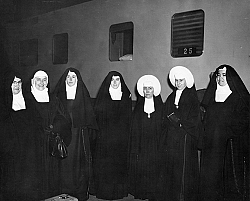Utah's Carmelites continue contemplative life that was established here 60 years ago
Friday, May. 15, 2015

Intermountain Catholic
+ Enlarge
The first group of Carmelites arrived in Utah by train in 1952 and were greeted by two Holy Cross sisters.
IC file photo
HOLLADAY — Two current sisters of the Carmel of the Immaculate Heart of Mary in Holladay were among the five founders who detrained on Dec. 7, 1952 at 6:30 a.m. in Salt Lake City: Mother Margaret Mary Miller and Sister Maureen Goodwin, the monastery’s former prioress.
The sisters came to Utah from Alhambra, Calif., to establish a foundation in the Diocese of Salt Lake City and inaugurated the first foundation of Discalced (barefoot or sandaled) Carmelite sisters in the Intermountain West, according to Salt of the Earth by Bernice Maher Mooney.
Within hours of arriving in Salt Lake City, the sisters were settled in their new convent at 1063 E. Second South and went to Mass at the Cathedral of the Madeleine celebrated by Bishop Hunt.
On Dec. 8, the Carmelite monastery received its first new member with the entry of Margaret Cheney, the former Margaret Romney of Salt Lake City, a convert from the Church of Jesus Christ of Latter-day Saints.
In 1956, the Carmelites moved to their present location, 5714 Holladay Blvd. The house was structurally unsound, however, and was demolished and replaced with the current building after a series of fundraisers. The Carmelite Fair remains the main source of income for the sisters.
Currently the monastery parlor is being remodeled and an entryway is being added so “people will know where our front door is located and so we can accommodate more people when there is a reception or when the volunteers are working on fair projects; they will have room to work and to store items,” said Mother Margaret Mary. “It looks much bigger than it is, but we needed the space so desperately.”
The new parlor will better accommodate the sisters and their prayer life, she added.
The Carmelites, who are cloistered, live a regimented life. The signal to rise is 5:25 a.m.; Divine Office is 5:45 a.m., followed by individual prayer.
Mass is 7:30 a.m. and breakfast 8:30 a.m.; followed by adoration of the Blessed Sacrament and work.
In addition to meals, work and recreation, they pray the Divine Office four times a day, visit the Blessed Sacrament, pray for the dying, have mental prayer and free time. They retire at 10 p.m.
“The evening office is our most important office of the day, which is followed by community prayer, the Litany of the Blessed Mother and commemoration to our Carmelite saints,” said Mother Margaret Mary. “From 7 to 8 p.m., we all come together and recreate; we embroider or make items for the fair. We have silence most of the time, but at 8 p.m., we have strict silence.”
Variations of the schedule occur on the first Friday of each month, when there is Exposition of the Blessed Sacrament, and what they call a Hermit Day, “where we take our meals privately, and are by ourselves as much as we can. On other days we eat together and have spiritual greetings,” Mother Margaret Mary said. “We have Exposition of the Blessed Sacrament also on the First Sunday of the month. We also have variations with a third Hermit Day and recreation days, where we can talk a lot and play music.”
Saint Teresa of Avila, who established the Discalced Carmelites with Saint John of the Cross in the 16th century, “kept things very balanced,” Mother Margaret Mary said. “That was one of her outstanding qualities.”
St. Teresa of Avila got her charism from the Carmels of Mount Carmel; the Carmelites were Christian hermits living in the Holy Land during the late 12th and early to mid-13th century.
“It was a tradition, but they were unorganized,” said Mother Margaret Mary. “Albert of Jerusalem wrote a rule for the hermits in the 12th century, which officially became the order. In the 14th century groups of women wanted to dedicate themselves to God and formed little groups.”
The Carmelites are cloistered and maintain “our strict enclosure because we have very intense prayer lives,” Mother Margaret Mary said. “It’s like being in the desert. We pray for the whole world past, present and future; they are all part of the vine and branches of the Lord. It is also very important to us to pray for people’s special intentions, their crosses.”
For questions, comments or to report inaccuracies on the website, please CLICK HERE.
© Copyright 2024 The Diocese of Salt Lake City. All rights reserved.
© Copyright 2024 The Diocese of Salt Lake City. All rights reserved.

Stay Connected With Us